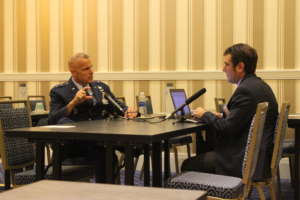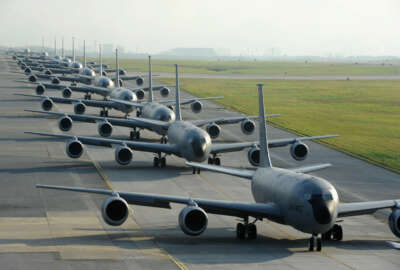New Air Force command gives leaders ‘enterprise view’ of mission support functions
The Air Force's decision to consolidate base support functions has gone some way toward the goal of reducing headquarters staffs, but officials see its real value...
It may be a few more years before the Air Force knows exactly how much money it’s saved by centralizing its base support functions within a single organization.
But at least a couple things are clear, according to the commander of the new Air Force Installation and Mission Support Center: the Air Force is performing more of its support functions with fewer people, and centralization has given the service access to data it’s never had before in order to make better management decisions.
The Air Force first ordered the creation of AFIMSC in 2014 as one of its responses to Defense Department mandates to lean down the military’s headquarters organizations. Until that point, Air Force bases were managed by 10 different major commands with their own support staffs for everything from contracting, to civil engineering, to services and logistics.
In all, 150 separate support programs were brought under AFISMC’s umbrella at Joint Base San Antonio. Maj. Gen. Brad Spacy, the center’s commander, said the structure has clearly made the Air Force more efficient, but the real value may be in delivering an “enterprise view” of information to senior leaders that was never accessible before.

“We’re finally getting at questions that we’ve struggled with for my whole career,” Spacy said in an interview for Federal News Radio’s On DoD. “For instance, an industry standard for investing in an installation would be about 2 percent to 4 percent of your plant replacement value. The Air Force has been struggling to meet that for a number of years, and it’s easy to kick that can down the road. What’s the impact of that? Well, no one knows. But now we can put objective numbers to that. The cost of that deferred sustainment has never been known before, and we did it in a year. We are starting to manipulate that data to produce decision-level information for the four-stars to make when they’re making those big planning choices-type decisions.”
Spacy said his command was preparing to take that data to Air Force senior leaders for the first time to help inform their decisions about facility maintenance.
“So we can go to the four-stars and say, hypothetically, ‘OK, you have 10 major commands, all their infrastructure is in bad shape. What do you want to prioritize?’ We can do it by core function or by mission area. Or, if it’s a geographic region, or electrical systems, or utilities or roofs, we can break it down any way you want. We can show you an investment profile and what it will do for the plant, but also the risk that you’re assuming if you don’t do it.”
Spacy said that level of integration is possible because the Air Force decided to consolidate not just the MAJCOM functional managers that formerly handled “intermediate level” support services for each of the 10 major commands, but also the functional area managers that formerly reported to various elements of the service’s Air Staff at the Pentagon, including the Security Forces Center, Civil Engineering Center, Installation Contracting Agency and Financial Services Center.
“It’s also given us the ability to look at our deployment mission cross-functionally or multi-functionally — and those were words we didn’t really use a year-and-a-half ago,” he said. “I mean, the idea that one airman can do more than one function, that just happened from people from all those functions sitting together in a room, saying, ‘You know, we deploy that team, and so do we, and so do we. What if we all were trained a little bit differently, so you could deploy one smaller team of cross-functional trained airmen?’ That’s not what we were built for, and we’re just scratching the surface on it, but we’re doing it because it’s good.”
The Air Force’s decision to stand up the new center came under some initial criticism from members of Congress, including Senate Armed Services Committee Chairman John McCain (R-Ariz.), who argued that the Air Force was violating the intent of the Pentagon’s headquarters reduction efforts by simply moving its support personnel from major commands to a new organization.
But Spacy contended the efficiencies are real: he said 600 of those billets have already been eliminated as part of the transition and 400 more will be cut by 2021.
“And what they’re not taking into account is the things we’ve been able to do that we didn’t know about,” he said. “And that’s a real hard thing to quantify because we’re learning about it every day. We’re learning how we can help the functionals design new force presentation options. We can do that because we have all the functions living together in one place. We didn’t think about that, and it wasn’t one of the visions, but it’s happening, and that’s huge.”
Copyright © 2025 Federal News Network. All rights reserved. This website is not intended for users located within the European Economic Area.
Jared Serbu is deputy editor of Federal News Network and reports on the Defense Department’s contracting, legislative, workforce and IT issues.
Follow @jserbuWFED




